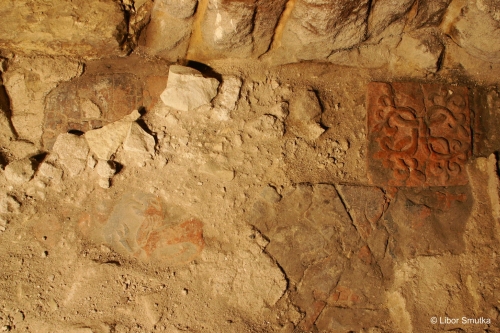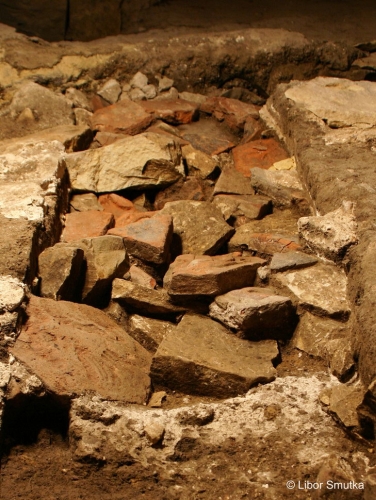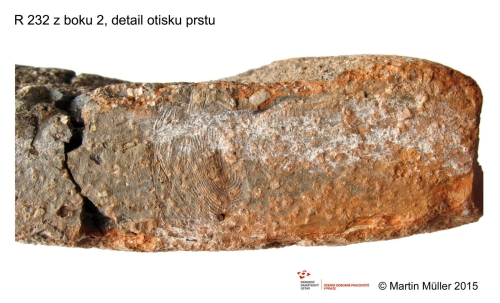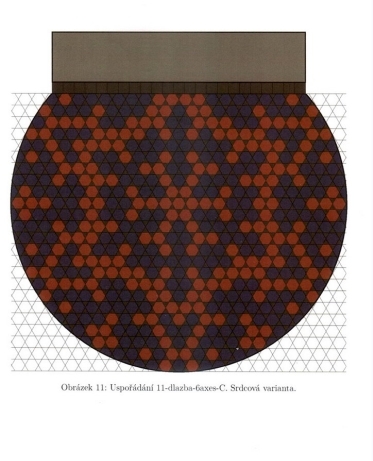Tiling
Discovery of tiles – an archaeological miracle
Wednesday, March 17, 2004, was a working day like any other and nobody could imagine that it was to become a significant date for Czech history. The circular masonry of the Rotunda had already been identified several weeks before, but a great surprise still lay dormant in the north-eastern part of the nave. Under a layer of crumbling mortar and marlstone fragments from an early Gothic building, a high, brick-coloured plait relief suddenly appeared. It was a very well preserved embossed ceramic tile of square shape. After a while, a figure of a lion was uncovered as it appeared on a hexagonal tile, and another one right next to it.

It was beyond all doubt: Romanesque tiling has just been discovered, similar to the one that once graced St. Lawrence’s Basilica at Vyšehrad. Covered by the later stone tiles, it remained hidden from sight for more than 725 years. The fact that the discovery of such significance was made on March 17, the day the Orthodox Church celebrates the feast of Translation of St. Wenceslas’ relics to Prague according to the Julian calendar, could be viewed with only slight exaggeration as yet another miracle connected with the Saint’s name.
The team of archaeologists managed to gradually uncover and document the finding of 74 tiles and their fragments. The surviving floor fragment is composed of 74 tiles laid out in five rows, of which 22 tiles are hexagonal ones with the motifs of a lion and a gryphon embossed on them. The Romanesque tiling preserved in its original position (in situ) consists of 22 embossed hexagonal ceramic tiles, smoothly glazed triangular ones, and girdled square tiles. During on-site research, 163 displaced smaller and larger fragments were collected, and the total of 237 tiles and fragments was documented.

Many tiles featured fingerprints, palm and tool prints that belonged to those engaged in their making more than 900 years ago.

Vyšehrad-type tiling
The combination of embossed hexagonal, triangular, and square tiles is characteristic of the oldest – the Vyšehrad – type of Czech medieval floors. Exactly this combination can also be found in the rotunda. The floor acquired its name from the type of tiling in St. Lawrence Basilica, a discovery made in 1884 that attracted extraordinary attention at the time and sparked subsequent related research. Fragments of this type of tiles were also found in other sacral buildings, such as the Sázava Monastery or St. Lawrence Church in Starý Plzenec. However, the tiles here were found among the waste material only. 120 years after the discovery of the tiling at Vyšehrad, another Vyšehrad-type floor was found in the Lesser Town rotunda. Unlike other tiled floors, the tiles here remained in their original position, making it a completely unique archaeological finding.
Tiling pattern design – a challenge for both the public and the restorer
One of the aims of the Preservation Project of St. Wenceslas Rotunda was also the production of a tiling replica that would cover the whole surface of the rotunda’s nave. As it soon turned out, the tiling design here was not accidental but emerged from an elaborate procedure carried out according to a prearranged plan. The same challenge awaited the Faculty of Mathematics and Physics, who decided to announce a competition seeking a reconstruction of the possible arrangement of the lion and gryphon tiles in the circular space of the Romanesque rotunda. The contestants were asked to base their designs on the surviving fragment that formed only 4.74% of the originally tiled area. From the total of 30 submitted patterns, the jury selected the winning design proposing a symmetrical, heart-shaped grouping of tiles, submitted by doc. Oldřich Semerák.

Painstaking work of the restorer then followed to ensure maximum possible authenticity of the manufacturing process as well as chemical composition of the tiles. All in all, 150 tiles with sculpturally reconstructed motifs of lions and gryphons and 300 glazed triangular tiles were laid down in the rotunda.
Tiling reconstructed according to the winning proposal